AMD Radeon 6900 & 6800 Updated
Over time we find the need to update and renew benchmarks. In my initial review of the AMD Radeon HD 6800 and 6900 Series, we only had time to test the games that were already in our test stable from the Radeon HD 5000 series reviews and benchmarking. Unfortunately, many of these games were older, and ended up being CPU board and/or not fully showcasing the DX11 improvements in the Radeon HD 6900 series.
At the end of those reviews, I laid out plans to update benchmarks to include newer games. I began this new testing with my Radeon HD 5870 Eyefinity6 benchmarking of 3x1 and 5x1 Eyefinity rigs. This article brings these new benchmarks to the Radeon HD 6800 and 6900 series. Additionally, I will also be updating all of my 5800 series benchmarks (on both new and old games) to utilize the current driver base and 16:9 monitors.
New games tested are:
- Aliens vs. Predator
- F1 2010
- Heaven v2
- Just Cause 2
- Mafia II
Here is a picture of my test rig, which is detailed on the next page:
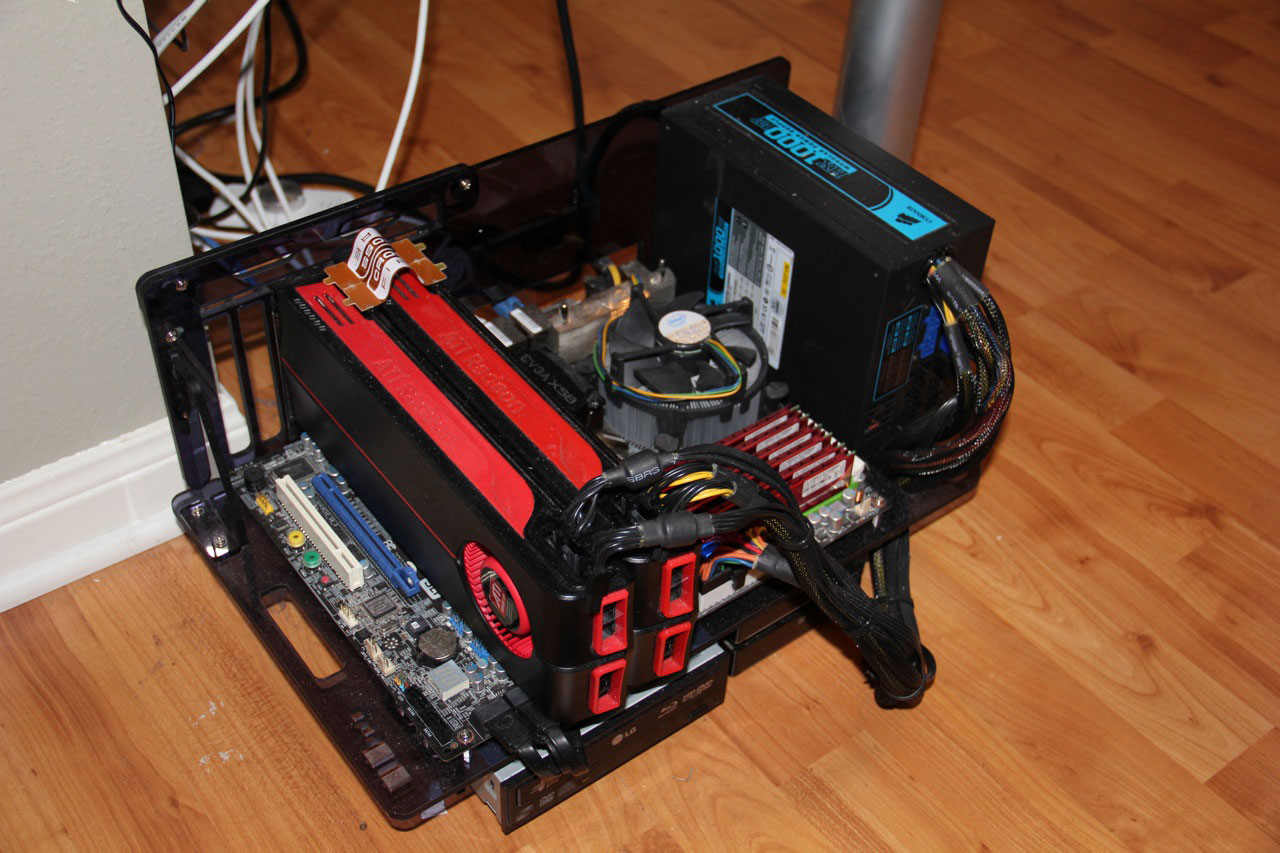
AMD Radeon 6900 & 6800 Updated - Benchmarking
System Specs
The Radeon HD 6900 and 6800 benchmarks were done on the 10.12 Driver Release. This is what initially brought the 5x1-Portrait and the new Catalyst UI. Since that time two driver updates have been released, but I've stayed at 10.12 for consistency.
- Windows 7
- EVGA X58 Tri-SLI Motherboard
- Intel i7 920 at 4x2.67GHz
- 12GB G.Skill DDR3 RAM
- 2x Samsung 320GB T-Series HDD (one for the OS and games; one for swap file and FRAPS)
- LG Super Multi Blu (HD-DVD/Blu-Ray Player)
- Onboard audio
- Corsair HX1000
- My Open PC Doma Pro PCI Case
- Logitch K340 Keyboard & Performance MX Mouse
- Ergotech Heavy Duty Triple Desk Stand
- 5x Dell U2211H IPS 16:9 1920x1080 Displays
My test rig remains unchanged, except for a new case. For easier testing, I recently migrated to the Doma Pro PCI test bench from My Open PC (review on that coming soon).
Hardware Tested
I only have AMD hardware tested for comparison in this review. This is not for lack of wanting to test NVIDIA hardware in Surround, but NVIDIA has not yet decided to support the WSGF with hardware for review and benchmarking. Considering that the WSGF is a hobby that just supports itself, I cannot justify spending the money needed to test NVIDIA cards.
Most of my time is spent working on the site (or other projects), and much of my "play time" is spent benchmarking. Cards would basically only be used for testing, and I cannot reconcile purchasing cards that would only be used for testing. It's simply not a good ROI.
Resolutions Tested
I tested both 1600x900 and 1920x1080 in widescreen, as well as 4800x900 and 5760x1080 in Eyefinity. This allows for comparison between panels in the 20" and 23" range, as well as performance improvements from dialing back the resolution on notch.
Games Tested
This benchmark update brings these games into my benchmark portfolio:
- Aliens vs. Predator
- F1 2010
- Heaven v2
- Just Cause 2
- Mafia II
Previously I had used the Just Cause 2 demo for benchmark. The full game offers three new benchmarks, and replaces the one in the demo. I am still using the desert sunset benchmark, but the one found in the full game is more demanding.
Also, I had previously used the first version of the Heaven demo. This now brings us current with the new second version.
Notes on Testing
In many areas, I am hitting a CPU limit in widescreen. In several instances the widescreen performance is hitting a wall at 100fps+. In some of these instances older cards appear to be outperforming newer cards by a couple fps. These minor differences are well within a margin of error, and should be considered identical performance.
Since I originally tested the 5800 series (well over a year ago), my system has gathered a certain amount of cruft due to games being installed and removed, and the video drivers being updated on a regular basis. While Windows 7 certainly handles "aging" much better than WinXP or Vista, this alone could account for the few fps difference (considering the difference is only a few percent variation).
Future Testing
I will also be re-benchmarking the higher end cards in the 5000-series on the newer drivers and on the 16:9 1920x1080 panels. This will ensure completely accurate comparisons.
AMD Radeon 6900 & 6800 Updated - Aliens vs. Predator
Aliens vs. Predator (AvP) is an FPS title from Rebellion Studios. It allows players to take on the role of either an Alien, a Predator or a human space marine. While the title received mixed reviews, it is a DX11 graphics powerhouse that can bring many machines to their knees.
The demo follows a number of Alien creatures, and makes extensive use of shaders and tessellation. Hitting 60fps in Eyefinity is not possible on a stock Core i7-920 (at max settings), even with a pair of AMD Radeon HD 6970's in CFX. Dropping to 3x1600x900 produces a noticeable increase in fps.

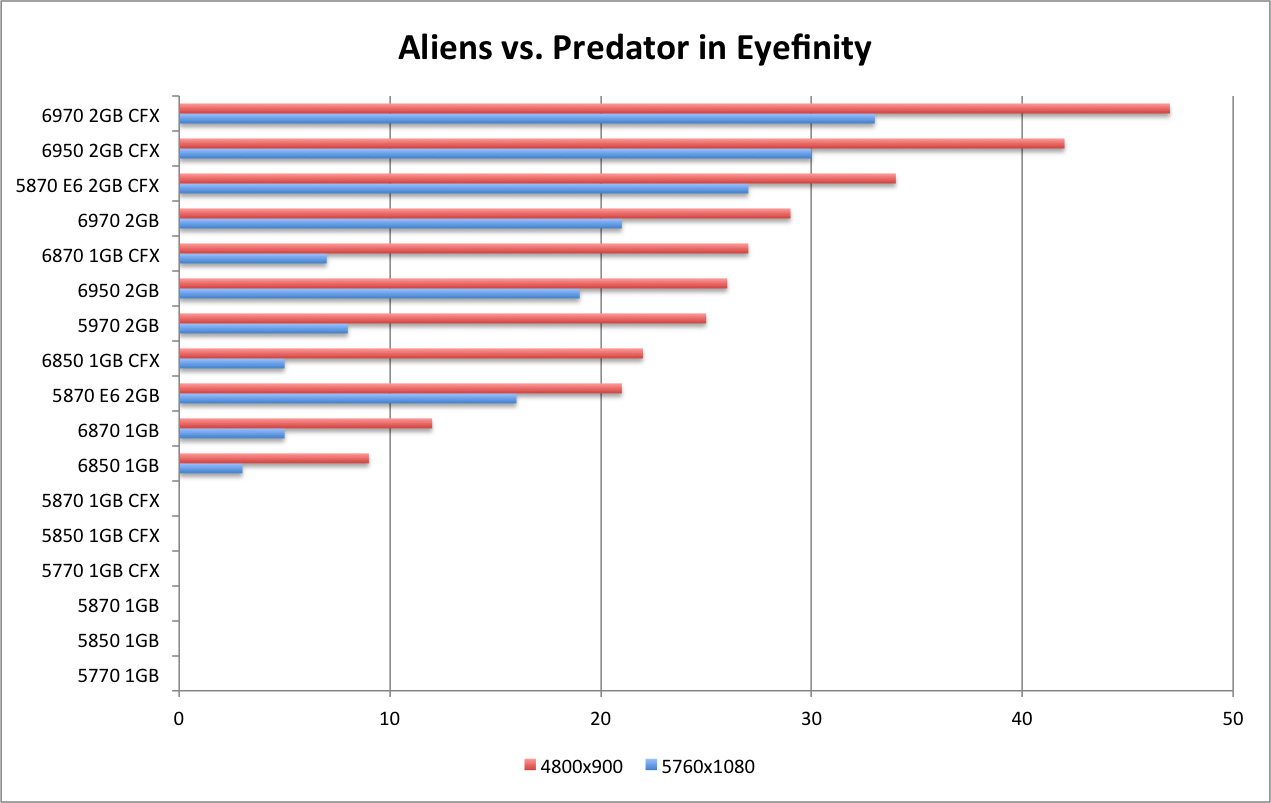
AMD Radeon 6900 & 6800 Updated - F1 2010
F1 (Formula 1) is a new racing title from Codemasters. Like their previous title (DiRT 2), F1 makes extensive usage of DX11 technology with cloth, fluid dynamics and tessellation. The title is much more strenuous on both single screen and Eyefinity, compared to DiRT 2.
At max settings the title hits a CPU cap (with a stock Core i7-920) of ~70fps on a single widescreen, with any pair of 6800 or 6900 series cards in CFX. Single 6900 series cards max out at just under 70fps.
A 2GB card is required for Eyefinity at 3x1920x1080p. 2GB cards in CFX max out at ~45fps, at both 3x1600x900 and 3x1920x1080. 1GB cards are playable at 3x1600x900, with the 6870 crossing 30fps.
I really don't understand why, but in a single widescreen 1920x1080 consistently outperformed 1600x900 by 1-2fps (at the CPU limit). I can't explain it, but I can repeat it. Maybe F1 just doesn't like an "odd" resolutions such as 1600x900. Maybe it is tuned for 1080p, and is having to do some sort of interpolation for 1600x900.
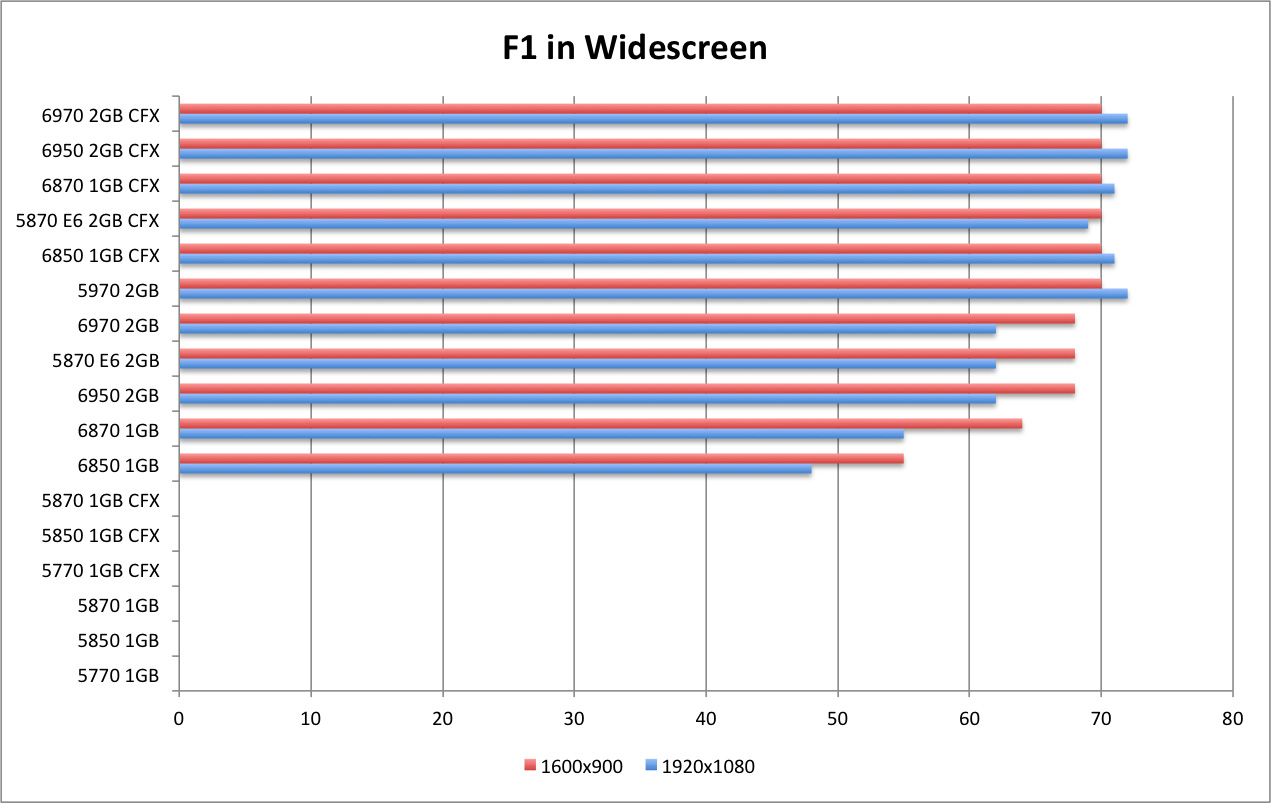

AMD Radeon 6900 & 6800 Updated - Heaven Demo v2
The Unigine Heaven Demo is unique in that it is the only demo which allows for the following components in one package:
- Synthetic Demo (i.e., a demo designed to "test" a system)
- Comparable tests of DX9, DX10 and DX11
- Is Hor+ (rather than limited to a few predefined aspect ratios)
The ability to compare DX9, DX10 and DX11 in the same environment allows for the unique ability to see how the different cards perform across these different comparable environments. Tessellation was set at Normal Mode.
The updated 2nd version of the Heaven demo offers more segments and more options. DX9 and DX10 runs are no match for any single 6800 or 6900 series card, with only the single 6800 series falling below 60fps. The DX11 run in more demanding in a single widescreen, requiring a 6900 series in CFX to pass 60fps (and pass it by a good margin). Single 6900 series cards also pass 30fps at either 1600x900 or 1920x1080.
Eyefinity is an obvious strain on any configuration. A 2GB card is required for Eyefinity in DX10 or DX11. No combination of cards will hit 60fps in DX9. Only the 6900 series will hit 30fps in DX10, and only a pair of 6970s will hit 30fps in DX11.
The Heaven v2 Demo continues to be a powerhouse in bringing graphics cards to their knees.
AMD Radeon 6900 & 6800 Updated - Heaven Demo v2 (DX9)
The Unigine Heaven Demo is unique in that it is the only demo which allows for the following components in one package:
- Synthetic Demo (i.e., a demo designed to "test" a system)
- Comparable tests of DX9, DX10 and DX11
- Is Hor+ (rather than limited to a few predefined aspect ratios)
The ability to compare DX9, DX10 and DX11 in the same environment allows for the unique ability to see how the different cards perform across these different comparable environments. Tessellation was set at Normal Mode.
The updated 2nd version of the Heaven demo offers more segments and more options. DX9 and DX10 runs are no match for any single 6800 or 6900 series card, with only the single 6800 series falling below 60fps. The DX11 run in more demanding in a single widescreen, requiring a 6900 series in CFX to pass 60fps (and pass it by a good margin). Single 6900 series cards also pass 30fps at either 1600x900 or 1920x1080.
Eyefinity is an obvious strain on any configuration. A 2GB card is required for Eyefinity in DX10 or DX11. No combination of cards will hit 60fps in DX9. Only the 6900 series will hit 30fps in DX10, and only a pair of 6970s will hit 30fps in DX11.
The Heaven v2 Demo continues to be a powerhouse in bringing graphics cards to their knees.
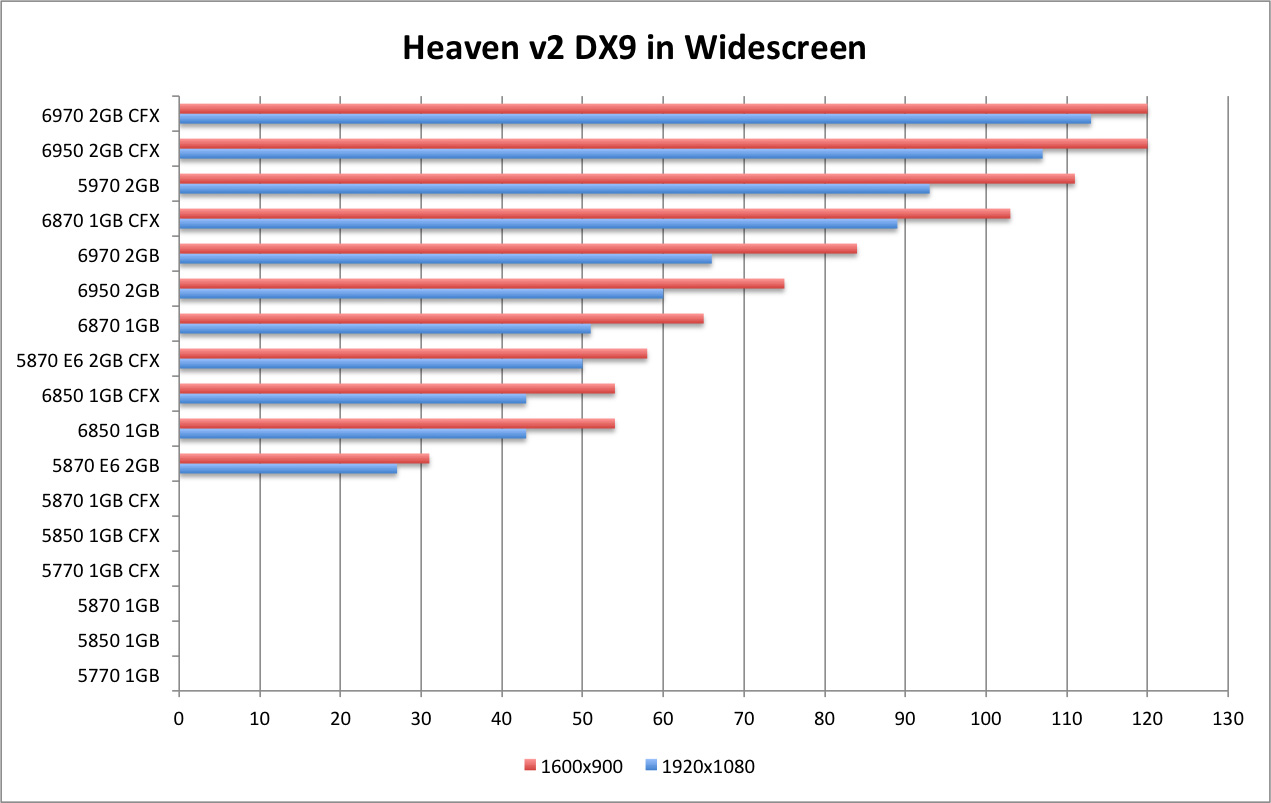
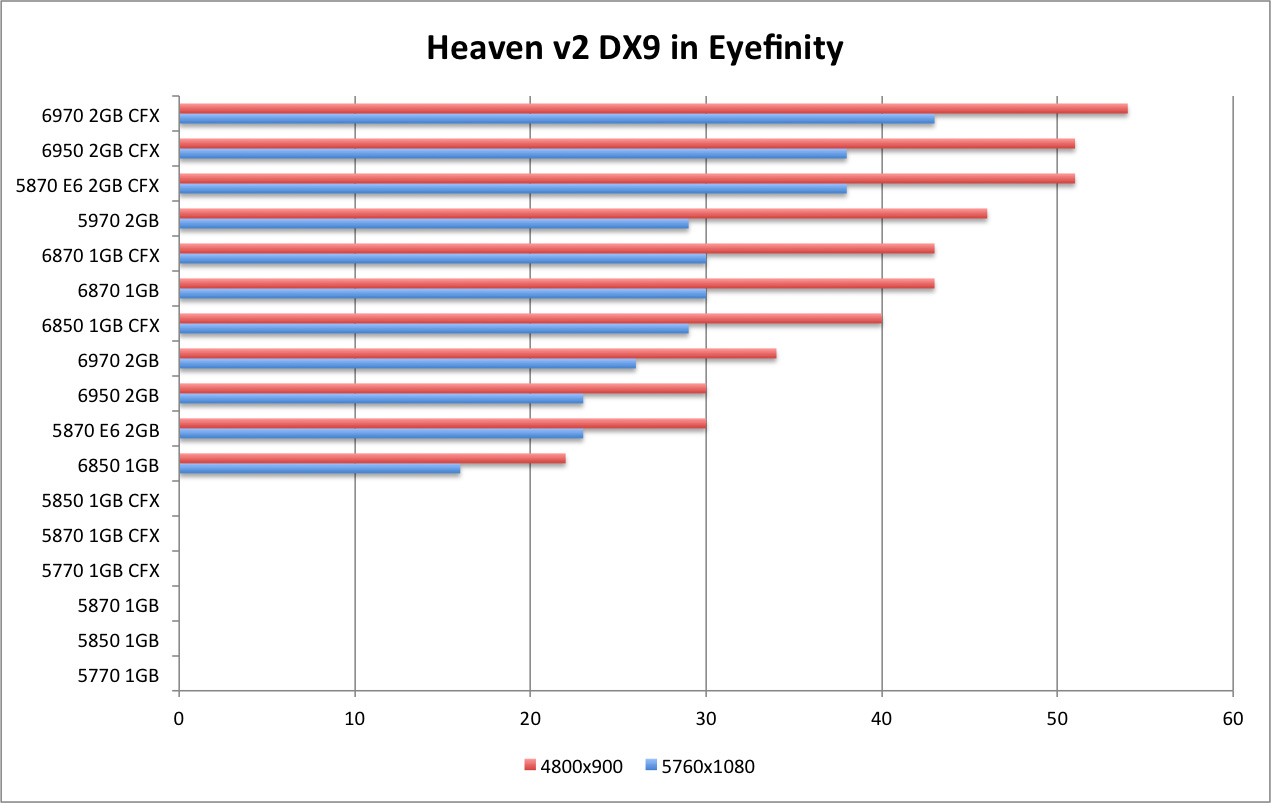
AMD Radeon 6900 & 6800 Updated - Heaven Demo v2 (DX10)
The Unigine Heaven Demo is unique in that it is the only demo which allows for the following components in one package:
- Synthetic Demo (i.e., a demo designed to "test" a system)
- Comparable tests of DX9, DX10 and DX11
- Is Hor+ (rather than limited to a few predefined aspect ratios)
The ability to compare DX9, DX10 and DX11 in the same environment allows for the unique ability to see how the different cards perform across these different comparable environments. Tessellation was set at Normal Mode.
The updated 2nd version of the Heaven demo offers more segments and more options. DX9 and DX10 runs are no match for any single 6800 or 6900 series card, with only the single 6800 series falling below 60fps. The DX11 run in more demanding in a single widescreen, requiring a 6900 series in CFX to pass 60fps (and pass it by a good margin). Single 6900 series cards also pass 30fps at either 1600x900 or 1920x1080.
Eyefinity is an obvious strain on any configuration. A 2GB card is required for Eyefinity in DX10 or DX11. No combination of cards will hit 60fps in DX9. Only the 6900 series will hit 30fps in DX10, and only a pair of 6970s will hit 30fps in DX11.
The Heaven v2 Demo continues to be a powerhouse in bringing graphics cards to their knees.
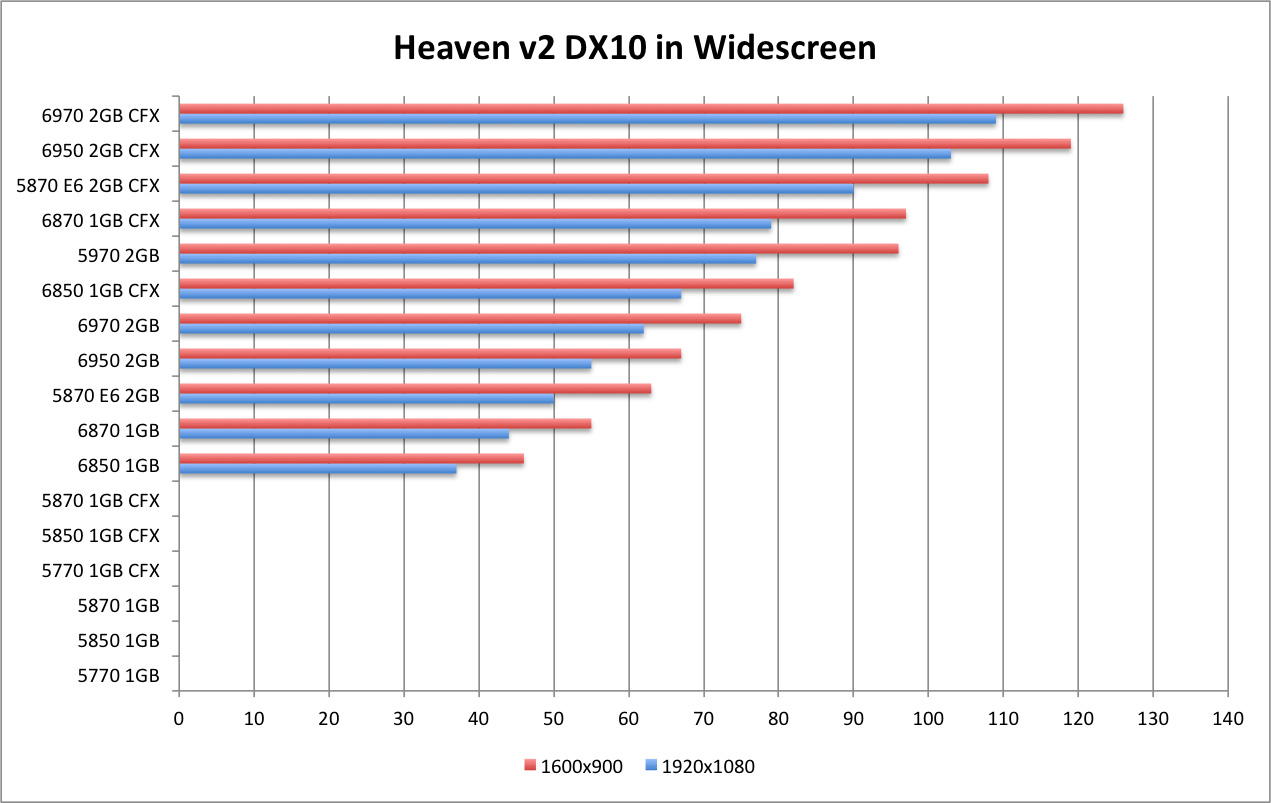

AMD Radeon 6900 & 6800 Updated - Heaven Demo v2 (DX11)
The Unigine Heaven Demo is unique in that it is the only demo which allows for the following components in one package:
- Synthetic Demo (i.e., a demo designed to "test" a system)
- Comparable tests of DX9, DX10 and DX11
- Is Hor+ (rather than limited to a few predefined aspect ratios)
The ability to compare DX9, DX10 and DX11 in the same environment allows for the unique ability to see how the different cards perform across these different comparable environments. Tessellation was set at Normal Mode.
The updated 2nd version of the Heaven demo offers more segments and more options. DX9 and DX10 runs are no match for any single 6800 or 6900 series card, with only the single 6800 series falling below 60fps. The DX11 run in more demanding in a single widescreen, requiring a 6900 series in CFX to pass 60fps (and pass it by a good margin). Single 6900 series cards also pass 30fps at either 1600x900 or 1920x1080.
Eyefinity is an obvious strain on any configuration. A 2GB card is required for Eyefinity in DX10 or DX11. No combination of cards will hit 60fps in DX9. Only the 6900 series will hit 30fps in DX10, and only a pair of 6970s will hit 30fps in DX11.
The Heaven v2 Demo continues to be a powerhouse in bringing graphics cards to their knees.

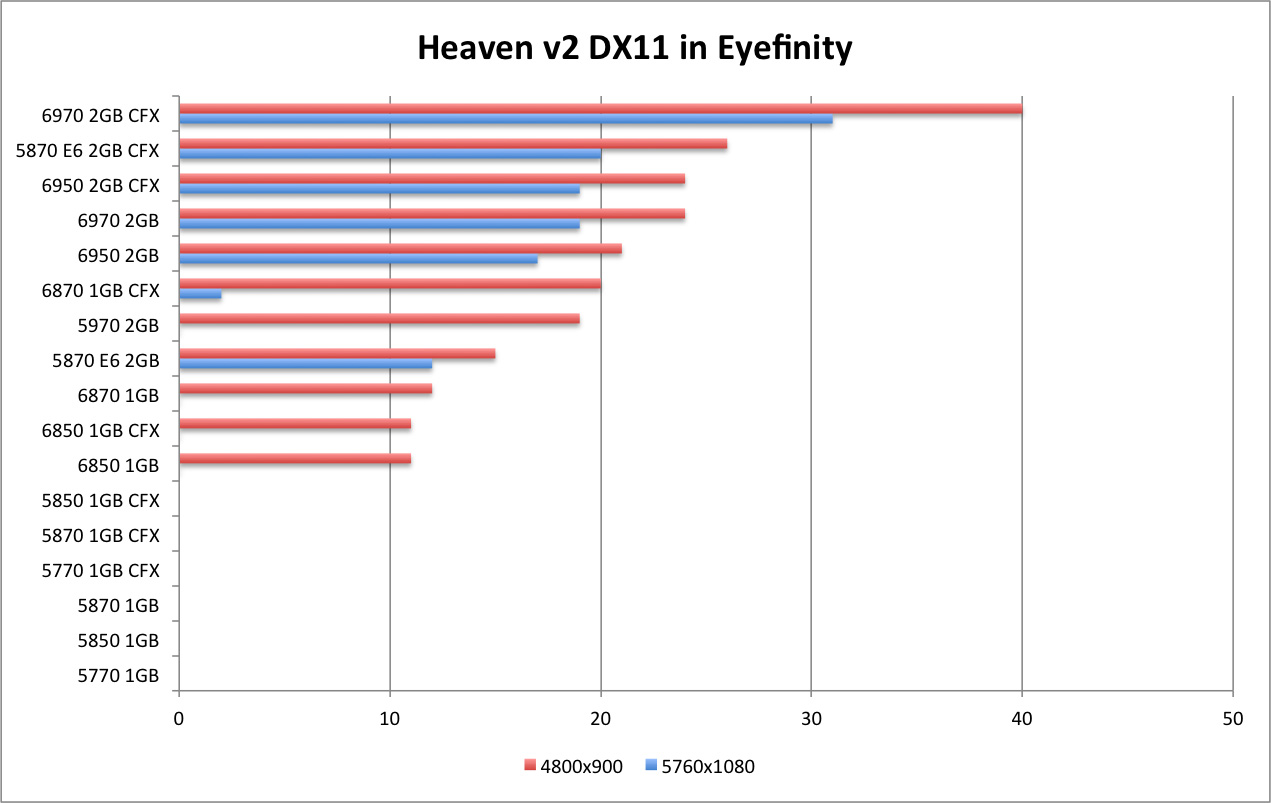
AMD Radeon 6900 & 6800 Updated - Just Cause 2
Just Cause 2 is the wildly popular sequal to the wildly popular Just Cause. You take control of protagonist Rico Rodriquez and rain down over the top destruction across a small desert island. The game is a free roaming title that offers literally limitless options to wreck havoc with your "hook shot" grapling device.
While the benchmark tool in the demo doesn't offer anything in the way of explosions or destruction, it does offer some beautiful scenery that is still quite demanding on multi-monitor environments.
The CFX configurations max out at 120fps for single widescreens, and top out at 60fps for Eyefinity. Single cards easily hit 60fps for widescreen and 30fps for Eyefinity. It's great to see a current, modern, and beautiful game performing this well across the whole range of cards and price points.


AMD Radeon 6900 & 6800 Updated - Mafia II
Mafia II is an open world "crime" title from 2K Games. It is the second game in the Mafia series. The demo comes with a built-in benchmark tool that offers both indoor and outdoor environments, various lighting effects and fire.
A single card won't quite hit 60fps in Eyefinity, but a CFX setup blows past consistently and we see a CPU limit at about 70fps in widescreen. Mafia II proves to be quite a demanding benchmark for Eyefinity, as only CFX configurations can consistently cross 30fps.


AMD Radeon 6900 & 6800 Updated - Conclusions
Conclusions
There are really no new conclusions over our previous benchmarks of the AMD Radeon HD 6800 and HD 6900 cards. Overall they perform well at extreme attractive price points, with great heat, power and noise profiles. While our earlier tests showed marginal improvements in many areas (especially with a single widescreen), these DX11-focused tests show greater improvements over the Radeon HD 5800 series.
Final Thoughts
In many of these tests (especially in single widescreen), the stock Intel Core i7-920 is becoming a bottleneck. While I think it will serve well enough through the upcoming "Antilles" Dual-GPU 6990 testing (whenever that is), the 2+ year old Nehalem chip will need to be replaced to show differentiation between the GPUs. I will probably upgrade to a Sandy Bridge platform later in the year.
If AMD follows its previous release cycle (new architecture each September), I will certainly need to upgrade CPUs before the 7000 series come along. And to think, we're almost half way there...